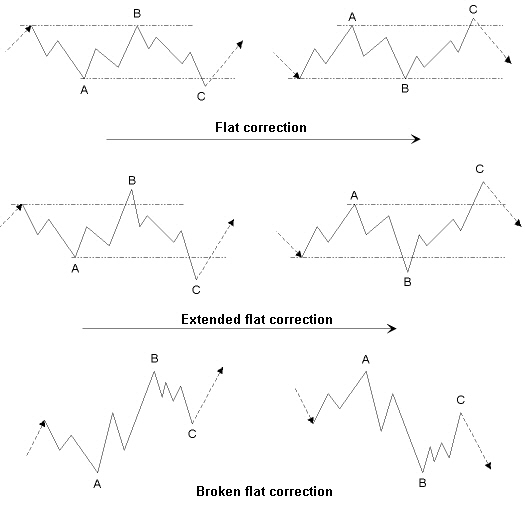Latest News
2022 Start working on a new website
BBS Trading Expert
Watch the Youtube BBS video and here is a crude oil trading example
Want to know more about:
AXIOM business books awards, bronze medal! Thank You!
No longer available!
Favorite articles in 2010, 11, 12, 14 and 2015 S&C Readers' Choice Awards.
AXIOM Business Books Awards, bronze medal.
Technical Analysis Elliott Waves Part 5
Flat Corrections
Flat corrections are very common.

Figure 7.23: Flat corrections.
Special offer: "Capturing Profit with technical Analysis"
Note in figure 7.23 that waves A and B of a flat correction are both three-wave correction patterns. Wave C is an impulse pattern and usually does not pass much farther than the end of wave A.
Flat corrections mostly can be found in B waves, but they appear also in waves 2 and 4. In an extended flat correction, waves B and C move past wave A. In a broken flat correction, wave A is passed by wave B, but wave B is still a correction pattern.
Rules and Guidelines
- Wave A can be any correction pattern.
- Wave B can be any kind of correction pattern, except a triangle.
- Wave B takes at least 50% back of wave A.
- Wave B is never more than 200% of wave A.
- Wave C is an impulse wave or an ending wedge impulse pattern.
- Wave C is never more than 300% of wave A.
- Wave C is never more than 200% of waves A and B.
- Wave C moves into the territory of wave A.
Double and Triple Flat Corrections
Just like with the zigzag, in the flat correction, we have variants with a double and a triple flat correction.
A double flat correction is quite common, and a triple flat correction is rare.
A double flat correction is composed of two flat corrections connected via a correction pattern.
A triple flat correction is composed of three flat corrections connected via correction patterns.
We use WXY to denote a double flat correction, instead of the standard ABCXABC Elliott notation.
For the triple flat correction, this becomes WXYX²Z. This is a more consistent way of notation because more flat corrections of a lower order (ABC) are connected together by a higher order wave (XYZ).
Rules and Guidelines
- Wave W is any correction pattern, except a triangle or a double or triple pattern.
- Wave X is any correction pattern, except a triangle or a double or triple pattern.
- Wave X is a minimum 50% of wave W.
- Wave X is a maximum 400% of wave W.
- Wave Y is any correction pattern, except a double or triple pattern.
- Wave Y is bigger than wave X, except with a triangle pattern.
- Wave X² is any correction pattern, except a triangle or a double or triple pattern.
- Wave X² is a minimum 50% of wave Y.
- Wave X² is a maximum 400% of wave Y.
- Wave Z is any correction pattern, except a double or triple pattern.
- Wave Z is not a zigzag if wave Y is a zigzag.
Wave Z is bigger than wave X².
Elliott Waves Next -Previous -Part 1 -Part 2 -Part 3 -Part 4 -Part 5 -Part 6 -Part 7
STOCATA Stocks Technical Analysis HOME
Links
Find a Stock ticker symbol, enter the ticker and find a chart, news, fundamentals and historical quotes.
Risk Disclosure: Futures and forex trading contains substantial risk and is not for every investor. An investor could potentially lose all or more than the initial investment. Risk capital is money that can be lost without jeopardizing ones’ financial security or life style. Only risk capital should be used for trading and only those with sufficient risk capital should consider trading. Past performance is not necessarily indicative of future results.
Hypothetical Performance Disclosure: Hypothetical performance results have many inherent limitations, some of which are described below. no representation is being made that any account will or is likely to achieve profits or losses similar to those shown; in fact, there are frequently sharp differences between hypothetical performance results and the actual results subsequently achieved by any particular trading program. One of the limitations of hypothetical performance results is that they are generally prepared with the benefit of hindsight. In addition, hypothetical trading does not involve financial risk, and no hypothetical trading record can completely account for the impact of financial risk of actual trading. for example, the ability to withstand losses or to adhere to a particular trading program in spite of trading losses are material points which can also adversely affect actual trading results. There are numerous other factors related to the markets in general or to the implementation of any specific trading program which cannot be fully accounted for in the preparation of hypothetical performance results and all which can adversely affect trading results.
See more 'Legal Disclosures' in the bottom menu bar!


